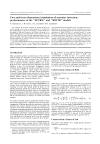performances of the "SUTRA" and "HST3D" models…
The problem of seawater intrusion in coastal aquifers and oceanic islands is not a new one and a great deal of research has been undertaken since the late 19th century. The first model was developed in 1888 and is known as the Ghyben-Herzberg. It is a simple model based on the hydrostatic balance between fresh and saline water. With the advent of large computing capacity over the past few decades, more sophisticated models have been developed for the simulation of seawater intrusion and upconing of saline water beneath a pumping well. Two of the latest developments in this area are the SUTRA and HST3D models. SUTRA is a two dimensional, finite-element, density dependent, solute transport model, while HST3D is a three-dimensional finite-difference model. This paper describes an application of these two models for the simulation of seawater intrusion in Nauru Island in the Pacific Ocean and it compares their performances. While SUTRA is a powerful model, it cannot adequately simulate three-dimensional problems, because of its two-dimensional nature. On the other hand, HST3D is suitable for the three-dimensional simulation of seawater intrusion, but it requires a small grid size and short time steps. This leads to the solution of a significantly large set of linear equations, necessitating the availability of sophisticated computing facilities in terms of memory and computing power. This makes the use of present-day supercomputers an inevitable requirement.
Data and Resource
| Field | Value |
|---|---|
| Publisher | Nauru Department of Commerce, Industry and Environment |
| Modified | |
| Release Date | |
| Identifier | 12401e8e-7c56-4620-8b2b-422d2e2554d4 |
| Spatial / Geographical Coverage Location | Nauru |
| Relevant Countries | Nauru |
| License |
Public
![[Open Data]](https://assets.okfn.org/images/ok_buttons/od_80x15_blue.png)
|

